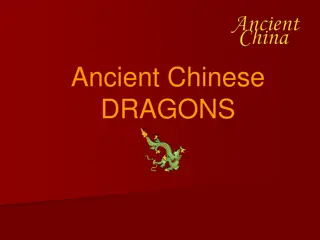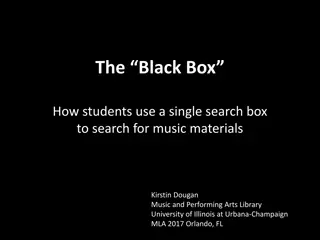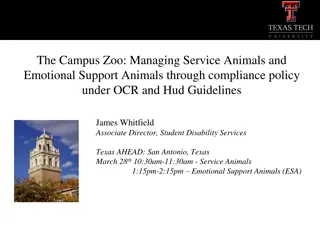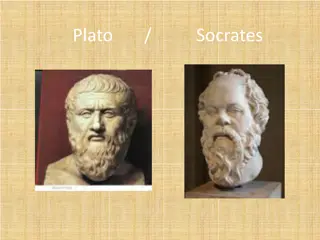Exploring Mythical Animals: Yeti Finger Discovery and Search for New Species
The passage discusses the discovery of a Yeti finger in Nepal, which was later confirmed to be from a human through DNA testing. It questions the existence of mythical animals like the Yeti and emphasizes the ongoing search for new animal species, citing examples such as the Okapi and Saola. The text highlights the importance of scientific evidence in debunking myths surrounding mysterious creatures, urging a shift in focus from well-known legends to more plausible scientific findings.
Download Presentation

Please find below an Image/Link to download the presentation.
The content on the website is provided AS IS for your information and personal use only. It may not be sold, licensed, or shared on other websites without obtaining consent from the author. Download presentation by click this link. If you encounter any issues during the download, it is possible that the publisher has removed the file from their server.
E N D
Presentation Transcript
12th GRADE ENGLISH PREPARATION FOR UNIVERSITY ENTRANCE EXAM PART - 15
PART PART - - 15 15 12th Grade English Sorular a a daki par aya g re cevaplay n z. The news that a Yeti finger found in Nepal is from a person, not a new species of giant Himalayan ape, will not surprise many. The notion that it came from a Yeti was laid to rest by a DNA test at Edinburgh Zoo. Yet again, evidence thought to demonstrate the existence of the famous mystery animal has failed the test. Every year, naturalists go to remote areas in search of mythical animals. Do they ever meet success? The answer is yes. The most famous example is the Okapi, a relative of the giraffe. So, could new species of large animals still await discovery? New species are found all the time. A long-horned relative of the cattle, the Saola, was discovered in Asia, in 1992, while more than 10 new primate species have been named since 2005. But some mystery animals appear unlikely. They are reported from well-studied areas like North America and have been the subject of unsuccessful discovery attempts. The time has come to stop combing North America for Bigfoot, or looking for Yetis in the Himalayas. There is no reason to take their existence seriously. According to the passage, the Yeti finger ----. A) has very unusual DNA and needs further investigation B) came from a human and not a Yeti as some previously believed C) could belong to a species of Himalayan ape not yet discovered D) is a part of the body of a larger animal discovered in Nepal E) has convinced investigators to continue to search for Yetis
PART PART - - 15 15 12th Grade English Sorular a a daki par aya g re cevaplay n z. The news that a Yeti finger found in Nepal is from a person, not a new species of giant Himalayan ape, will not surprise many. The notion that it came from a Yeti was laid to rest by a DNA test at Edinburgh Zoo. Yet again, evidence thought to demonstrate the existence of the famous mystery animal has failed the test. Every year, naturalists go to remote areas in search of mythical animals. Do they ever meet success? The answer is yes. The most famous example is the Okapi, a relative of the giraffe. So, could new species of large animals still await discovery? New species are found all the time. A long-horned relative of the cattle, the Saola, was discovered in Asia, in 1992, while more than 10 new primate species have been named since 2005. But some mystery animals appear unlikely. They are reported from well-studied areas like North America and have been the subject of unsuccessful discovery attempts. The time has come to stop combing North America for Bigfoot, or looking for Yetis in the Himalayas. There is no reason to take their existence seriously. It is stated in the passage that searches for mythical animals ----. A) should be done after certain tests are carried out B) are done by very experienced explorers C) need to be carried out by specialists D) depend on funding from zoos E) can sometimes yield satisfactory results
PART PART - - 15 15 12th Grade English Sorular a a daki par aya g re cevaplay n z. The news that a Yeti finger found in Nepal is from a person, not a new species of giant Himalayan ape, will not surprise many. The notion that it came from a Yeti was laid to rest by a DNA test at Edinburgh Zoo. Yet again, evidence thought to demonstrate the existence of the famous mystery animal has failed the test. Every year, naturalists go to remote areas in search of mythical animals. Do they ever meet success? The answer is yes. The most famous example is the Okapi, a relative of the giraffe. So, could new species of large animals still await discovery? New species are found all the time. A long-horned relative of the cattle, the Saola, was discovered in Asia, in 1992, while more than 10 new primate species have been named since 2005. But some mystery animals appear unlikely. They are reported from well-studied areas like North America and have been the subject of unsuccessful discovery attempts. The time has come to stop combing North America for Bigfoot, or looking for Yetis in the Himalayas. There is no reason to take their existence seriously. It can be understood from the passage that searches for the Yeti or Bigfoot ----. A) are unnecessary because reports of these animals come from areas that have already been investigated thoroughly B) could be successful, and serious investigations of reported sightings should continue C) have fortunately led to the discovery of the Okapi and the Saola D) should be done by scientists who have specialized in primate and large ape behaviour E) should be carried out in areas other than the well-studied areas of the Himalayas
PART PART - - 15 15 12th Grade English Sorular a a daki par aya g re cevaplay n z. Although aardvarks look like anteaters, they are actually related to elephants! But wait what s an aardvark? The unusual mammal called the aardvark was named by South Africans in the 1880s. In the local language, Afrikaans, aardvark means earth pig . This name quite accurately describes a large, heavily built animal with thin hair and short legs, that looks much like a pig. Aardvarks live in dry places like Africa, south of the Sahara Desert. The aardvark can reach a length of 1.8 metres. Its head has huge donkeylike ears, a long snout, and drooping eyelids with long eyelashes. Aardvarks prefer to sleep during the day in an underground burrow. At night, they dig underground for their favourite food: termites. They break open the termites nests with their massive, flattened claws and then suck up the insects. Female aardvarks give birth to one baby every year. A few weeks after it is born, the baby aardvark begins to follow its mother around. It goes off to live on its own before it is one year old. According to the passage, the aardvark s name is quite suitable because ----. A. of its donkeylike ears and long nose B. it eats a lot of pig meat C. it is from South Africa D. it is related to the pig family E. of its resemblance to a real pig
PART PART - - 15 15 12th Grade English Sorular a a daki par aya g re cevaplay n z. Although aardvarks look like anteaters, they are actually related to elephants! But wait what s an aardvark? The unusual mammal called the aardvark was named by South Africans in the 1880s. In the local language, Afrikaans, aardvark means earth pig . This name quite accurately describes a large, heavily built animal with thin hair and short legs, that looks much like a pig. Aardvarks live in dry places like Africa, south of the Sahara Desert. The aardvark can reach a length of 1.8 metres. Its head has huge donkeylike ears, a long snout, and drooping eyelids with long eyelashes. Aardvarks prefer to sleep during the day in an underground burrow. At night, they dig underground for their favourite food: termites. They break open the termites nests with their massive, flattened claws and then suck up the insects. Female aardvarks give birth to one baby every year. A few weeks after it is born, the baby aardvark begins to follow its mother around. It goes off to live on its own before it is one year old. What can be inferred from the passage about young aardvarks? A) They tend to live in family groups. B) They sleep at night until they reach maturity. C) They are independent creatures. D) They live in the Sahara Desert. E) Their mothers follow them around until maturity.
PART PART - - 15 15 12th Grade English Sorular a a daki par aya g re cevaplay n z. Although aardvarks look like anteaters, they are actually related to elephants! But wait what s an aardvark? The unusual mammal called the aardvark was named by South Africans in the 1880s. In the local language, Afrikaans, aardvark means earth pig . This name quite accurately describes a large, heavily built animal with thin hair and short legs, that looks much like a pig. Aardvarks live in dry places like Africa, south of the Sahara Desert. The aardvark can reach a length of 1.8 metres. Its head has huge donkeylike ears, a long snout, and drooping eyelids with long eyelashes. Aardvarks prefer to sleep during the day in an underground burrow. At night, they dig underground for their favourite food: termites. They break open the termites nests with their massive, flattened claws and then suck up the insects. Female aardvarks give birth to one baby every year. A few weeks after it is born, the baby aardvark begins to follow its mother around. It goes off to live on its own before it is one year old. The main purpose of this passage is to ----. A) describe the physical characteristics of the aardvark B) inform readers about the general habits of aardvarks C) give general information about aardvarks D) explain why aardvarks are not related to anteaters E) give specific information about the mating habits of aardvarks
PART PART - - 15 15 12th Grade English Sorular a a daki par aya g re cevaplay n z. From its beginnings as a small village in central Italy, the city of Rome came to rule over one of the largest and most prosperous empires in history. Its armies were seemingly unstoppable, conquering most of Europe, North Africa and the Middle East, almost the entire world known to the mankind at that time. Rome was founded in 753 BCE, and at first was ruled by kings. In 509 BCE, the kings were replaced by a republic and control of the city fell to consuls chosen by the Senate (ruling council). The Senate and later the emperor also appointed generals to lead Rome s armies in wars of conquest. They divided the captured regions into provinces controlled by Roman governors and guarded by Roman soldiers. They built new cities and roads and imposed Roman laws on their conquered subjects. Although they could be cruel, especially to people who rebelled against them, the Romans spread wealth, stability, and valuable new ideas all across their empire.The Romans are still remembered for their politics and philosophy, which inspired the European thinking for many centuries. Many of their buldings, supported by advanced engineering skills, still stand today. It is understood from the passage that the Romans ----. A) were known for their kings, architecture, wars and politics B) had a strong army that was more powerful than the Senate C) ruled most of the ancient world with the help of their strong armies D) made a number of laws to promote the advancement of architecture E) were ruled by kings and the Senate at the same time throughout their history
PART PART - - 15 15 12th Grade English Sorular a a daki par aya g re cevaplay n z. From its beginnings as a small village in central Italy, the city of Rome came to rule over one of the largest and most prosperous empires in history. Its armies were seemingly unstoppable, conquering most of Europe, North Africa and the Middle East, almost the entire world known to the mankind at that time. Rome was founded in 753 BCE, and at first was ruled by kings. In 509 BCE, the kings were replaced by a republic and control of the city fell to consuls chosen by the Senate (ruling council). The Senate and later the emperor also appointed generals to lead Rome s armies in wars of conquest. They divided the captured regions into provinces controlled by Roman governors and guarded by Roman soldiers. They built new cities and roads and imposed Roman laws on their conquered subjects. Although they could be cruel, especially to people who rebelled against them, the Romans spread wealth, stability, and valuable new ideas all across their empire.The Romans are still remembered for their politics and philosophy, which inspired the European thinking for many centuries. Many of their buldings, supported by advanced engineering skills, still stand today. How did the Romans control their huge Empire? A) The Senate assigned generals to go to war with their armies. B) They formed small regions which were under the control of specific generals and armies. C) The Senate and the Emperor formed conflicting rules to govern the Empire. D) They severely punished people who did not obey their rules. E) The generals became more powerful than the Senate and formed Roman laws.
PART PART - - 15 15 12th Grade English Sorular a a daki par aya g re cevaplay n z. From its beginnings as a small village in central Italy, the city of Rome came to rule over one of the largest and most prosperous empires in history. Its armies were seemingly unstoppable, conquering most of Europe, North Africa and the Middle East, almost the entire world known to the mankind at that time. Rome was founded in 753 BCE, and at first was ruled by kings. In 509 BCE, the kings were replaced by a republic and control of the city fell to consuls chosen by the Senate (ruling council). The Senate and later the emperor also appointed generals to lead Rome s armies in wars of conquest. They divided the captured regions into provinces controlled by Roman governors and guarded by Roman soldiers. They built new cities and roads and imposed Roman laws on their conquered subjects. Although they could be cruel, especially to people who rebelled against them, the Romans spread wealth, stability, and valuable new ideas all across their empire.The Romans are still remembered for their politics and philosophy, which inspired the European thinking for many centuries. Many of their buldings, supported by advanced engineering skills, still stand today. Which of the following is true about the Roman Empire? A) It was established many years ago in the Middle East. B) It grew stronger with the help of formidable defensive structures. C) It was governed by the kings and divided later on by the ruling council. D) It influenced Europe with its developments in politics and philosophy. E) It had one of the largest armies in the Middle East.
PART PART - - 15 15 12th Grade English Sorular a a daki par aya g re cevaplay n z. Consumers purchase products and services to experience certain emotional states or achieve emotional goals in a process called emotional arousal. Emotions can create a feeling of pleasure or satisfaction, but they can also give the consumer the perception that their purchase will help them avoid a feeling of displeasure. No matter what the purchase is, consumers must somehow associate a positive emotional connection between a product and themselves. Positive emotions can include the fulfillment of a desire or the feelings of safety and protection. Consumers also have both unexpressed and expressed emotions. It is important to understand the difference between these emotions because if a consumer is purchasing but is not expressing any emotion toward a product, you may need to ask more questions in order to reach the customer on a deeper level. Doing so helps the consumers feel that they are somehow linked to your product and that it produces a favorable image of them. This reaction evokes consumer identification with your product and motivates them to buy and keep buying your product. How does buying something affect consumers emotions? A) It gives consumers a feeling of achievement. B) It causes consumers to have damaging thoughts. C) It influences every decision consumers make before purchasing. D) It leads to a condition of discomfort and misery. E) It results in a feeling of regret for purchasing too much.
PART PART - - 15 15 12th Grade English Sorular a a daki par aya g re cevaplay n z. Consumers purchase products and services to experience certain emotional states or achieve emotional goals in a process called emotional arousal. Emotions can create a feeling of pleasure or satisfaction, but they can also give the consumer the perception that their purchase will help them avoid a feeling of displeasure. No matter what the purchase is, consumers must somehow associate a positive emotional connection between a product and themselves. Positive emotions can include the fulfillment of a desire or the feelings of safety and protection. Consumers also have both unexpressed and expressed emotions. It is important to understand the difference between these emotions because if a consumer is purchasing but is not expressing any emotion toward a product, you may need to ask more questions in order to reach the customer on a deeper level. Doing so helps the consumers feel that they are somehow linked to your product and that it produces a favorable image of them. This reaction evokes consumer identification with your product and motivates them to buy and keep buying your product. It is important to comprehend the difference between unexpressed and expressed emotions because - ---. A) emotions are important in understanding why consumers buy certain products B) these expressions are evidence of how consumers can reach emotional goals C) when consumers identify themselves with a particular product, they keep buying it D) consumers need to get rid of any uncomfortable and unsafe feelings E) consumers make decisions based on perceptions rather than reality
PART PART - - 15 15 12th Grade English Sorular a a daki par aya g re cevaplay n z. Consumers purchase products and services to experience certain emotional states or achieve emotional goals in a process called emotional arousal. Emotions can create a feeling of pleasure or satisfaction, but they can also give the consumer the perception that their purchase will help them avoid a feeling of displeasure. No matter what the purchase is, consumers must somehow associate a positive emotional connection between a product and themselves. Positive emotions can include the fulfillment of a desire or the feelings of safety and protection. Consumers also have both unexpressed and expressed emotions. It is important to understand the difference between these emotions because if a consumer is purchasing but is not expressing any emotion toward a product, you may need to ask more questions in order to reach the customer on a deeper level. Doing so helps the consumers feel that they are somehow linked to your product and that it produces a favorable image of them. This reaction evokes consumer identification with your product and motivates them to buy and keep buying your product. Which of the following could be the main idea of this passage? A) It is important to evaluate the emotional needs of customers. B) Consumers satisfy all of their needs by purchasing products. C) The motivational process begins with the need for a certain product. D) Consumers are triggered by some specific emotions when buying a product. E) It is unclear whether emotions truly have an impact on consumer behaviour.
PART PART- -14 14 12th Grade English Thanks for your participation























